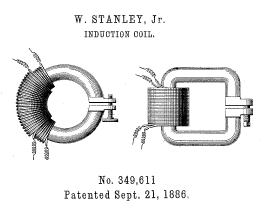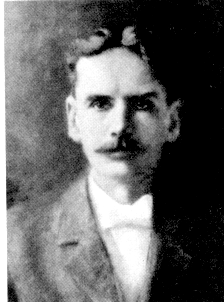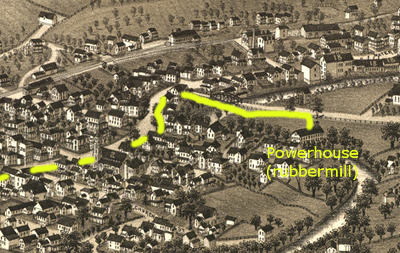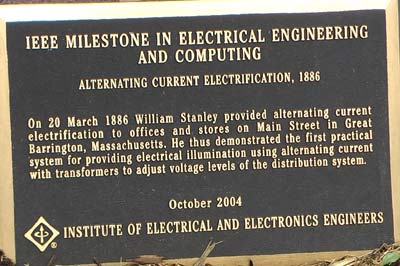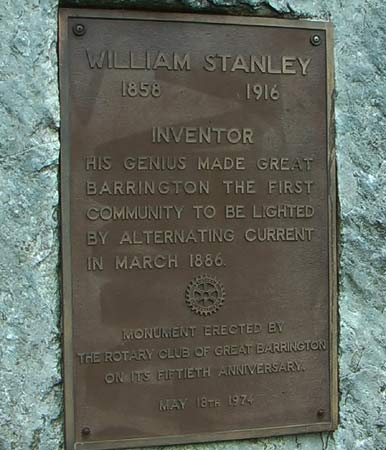Great Barrington 1886
Inspiring an industry toward AC power
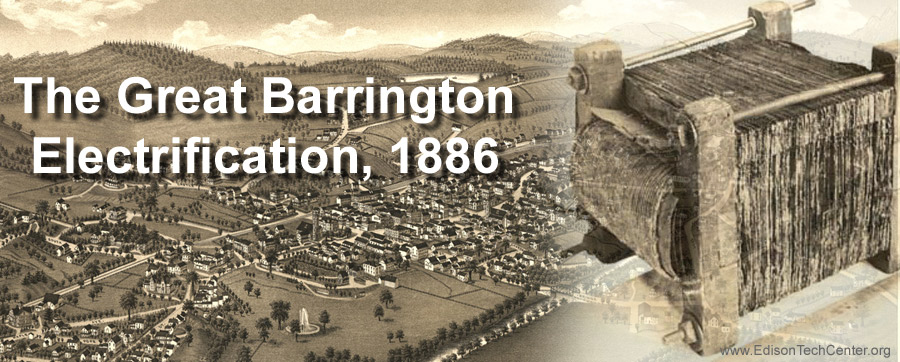
The AC demonstration system built in Great Barrington in 1886 by William Stanley, financed by Westinghouse was the greatest achievement in AC power until that point. This single event inspired George Westinghouse to dive into AC current system development with significant resources. This of course led to Westinghouse's great achievements a few years later, which in turn led to the formation of General Electric as an opposition to Westinghouse's success.
This event caught the attention of the entire electrical industry as it used the first modern transformers to make a complete distribution system. Stanley's big contributions were the design of an E-shaped core in the transformer and designing the induction coils in parallel instead of in series. Stanley also got valuable experience from this to help him advance the field of AC generators and full AC system design. Many engineers after this studied the Great Barrington experiment and learned from it.
Great Barrington: Battleground in the War of Currents
William Stanley had worked for Westinghouse in Pittsburgh and decided to set up this single phase AC experiment in Great Barrington, Massachusetts. Like many small but wealthy towns of the time one of Edison's companies had already installed a direct current power system. Stanley's system quickly showed superior flexibility in its use as Stanley kept adding more stores and mansions to his system. The DC power system had a limited in distance and did not compete. Stanley's system was however an experimental system designed to be proof of concept. It was short lived as the weak points in the system in the system eventually shut the system down (Westinghouse's steam engine was unreliable and the Siemens generator was 'unsatisfactory'). Stanley's transformers however proved to be a major step forward on the AC side of the 'war of currents'.
Features of this Power Generation Site:
Notable features: First alternating current demonstration with modern transformers
Frequency: 133-1/3 cycles (Hertz) (Historically referred to as "16,000 alternations per minute")
Single-Phase, Alternating Current
Power Transmission Length: 4000 ft
Power system built by: Westinghouse financially backed research on transformers, Siemens alternator, and Edison incandescent lights
Notable Engineers: William Stanley, Stanley system based on work of Lucien Gaulard and John D. Gibbs. Stanley worked with Oliver B. Shallenberger and Albert Schmid prior to going to Pittsfield.
Maximum Power Output: 25 horsepower steam engine powering one Siemens alternator, 500 volts output, reduced to 100 volts in each home/business
The Transformers:
Transformers are the 'heart' of AC power systems, they allow for changing voltage from low to high and back again, which allows one to send power over longer distances using high voltage (HV). HV is able to transmit power over great distances with minimal losses, however that power must be brought back down to lower, safer voltages for use in homes and businesses. The transformer is the only way to do this, and that is why Great Barrington's experiment is one of the most significant in the early history of AC power.
George Westinghouse saw opportunity in developing AC power systems when he saw they were performing well in rudimentary tests in Europe. He bought a Siemens Generator and the rights to the Gaulard and Gibbs transformer and assigned his best engineers William Stanley, Albert Schmid and Oliver B. Shallenberger to work on improving it. Stanley was the primary innovator developing a type of transformer with E-shaped plates and a complex set of windings. He had a superior understanding of electromagnetic forces which allowed him and his team to solve the problems at hand. Stanley had been playing with AC power designs since 1883 and was inspired by Charles F. Brush's work on batteries which got into counter electro-motive forces. There were two different transformer designs being developed in Europe, and Westinghouse's team's work was based on Gaulard and Gibbs (as opposed to the Hungarian ZBD system) and Stanley wrote later on:
"...we are indebted to them (Gaulard and Gibbs) for the interest they aroused in the possibilities of alternating current service."
Stanley also wrote that if Westinghouse had not chosen Gaulard and Gibb's transformer for the Great Barrington experiment we'd all be using the ZBD system which was "intelligently" designed.
Stanley developed the prototype transformer pictured below in 1885, it was robust, reliable and was a significant leap forward in technology.
While Stanley worked on prototypes in Pittsburgh he grew ill from the great air pollution caused by Andrew Carnegies steel mills. He had trouble breathing and doctors recommended he move to the country. Stanley had family in Great Barrington and decided to move his work there. With the approval of George Westinghouse he moved his laboratory there and proceeded to build the many transformers he would need to set up the demonstration.
Stanley continued to developed the transformer in the tranquility of his new home in Great Barrington. His first patented design was induction coils with single cores of soft iron and adjustable gaps in order to regulate the electromagnetic force which affects the secondary coil. He built 26 transformers in total, sending 10 back to Pittsburgh for use in a later demonstration system at Union Switch and Signal Company.
Above: The first Stanley Transformer that changed the world of electricity
The Great Barrington System:
He used a Siemens alternator driven by a Westinghouse steam engine in a rubber mill near Cottage Street. The alternator produced 500 volts and that was transmitted to Main Street. At one point he stepped up the voltage to 3000 volts and he connected a series string of 30 100 volt lamps, followed by another transformer which reduced it to 500 volts again. He did this to demonstrate that his transformers really did work. On Main Street he had 6 step-down transformers located in basements to bring down the power to 100 volts so it could be used for lights at each location. There were 36 incandescent bulbs total in all the shops that were lit by the system. The power transmission cable was strung up to the large Elm trees on the street. Stanley added more businesses to his system after the first 6 businesses. Eventually he lit 7 offices, 2 hotels and 13 stores on main street.
He used transformers in parallel to prevent load changes on one device from affecting all other devices downstream.
A transformer built by Stanley used in the first Great Barrington electrificationMoment of Truth:
March 6th, 1886 Stanley lit the downtown and rejoiced along with the townspeople. The system lit both businesses and the street with 150, 50, and 16 candlepower incandescent lamps. Stanley remarked how people were happy however maintained some distance from the lights as they were afraid of them!
Later on at his home Stanley dined with Massachusetts legislator Senator Hosmer. Stanley had been calling his transformers "converters" as there was no better simple name for them. Senator Hosmer suggested "transformer" and thus in a rare instance a politician actually coined the term for an engineers device.
On April 6, 1886 George Westinghouse and his entourage came to see the system in person. The 500 volt transmission had only 2% loss over 4000' distance and successfully lit downtown.
Stanley wrote:
"This visit determined Mr. Westinghouse to actively enter the alternating-current field, as the novelty and scope of the system surprised him greatly."The Great Barrington AC plant continued to operate until that summer when a technician dropped a screwdriver into the Siemens generator and destroyed it.
Photos of the Great Barrington Site:
The Great Barrington countryside today is much different than in the 1880's, in the time of Stanley it was stripped of all trees to make charcoal which was used to create super hot fires used to process iron ore located in these low mountains.
Siemens single phase AC generators (Alternators) in 1885. This illustration shows two generators in use in London. Stanley would use one of these types of Siemens generators in the rubbermill in Great Barrington. Stanley later wrote Westinghouse that the Siemens alternators proved to be a disappointment. Stanley then designed his own and sent the drawings to Westinghouse.
The rubbermill owned by Horace Day was rented by Stanley and used as a power house. A Westinghouse steam engine drove the Siemens generator.
The route of the powerlines across the river and towards main street.
IEEE Plaque near the site
Remains of the era close to the rubbermill site.
Main Street(right), on the corner of the two streets. Wires were most likely sent via the large trees in front of this property, but it is possible it was sent behind, and then turned right to meet main
The row of shops which were first lit by electric light in 1886. The wires supplying power were strung to large elm trees which used to grow on the right. The Dutch Elm Disease
The Future of Stanley:
William Stanley later split from Westinghouse and Oliver Shallenberger took his place as chief engineer. Stanley established the Stanley Electric Company in 1890 in nearby Pittsfield Massachusetts. There his company built and sold the first transformers. In 1903 General Electric bought the company and continued to develop transformers and capacitors there. The Stanley Electric Company is the root of GE's transformer and capacitor business. Read more about Stanley's life at our page here.
A postcard featuring the Stanley Electric Company in Pittsfield, MAArticle by M.Whelan, Steve Rockwell and Thomas Blalock
Sources:
The General Electric Story - A Hall of Electrical History Publication (book)
Wikipedia article on transformers
MIT website: Inventor of the Week" William Stanley
IEEE Global History Network: Milestones: Alternating Current Electrification 1886
The Power Makers: Steam, Electricity, and the Men Who Invented Modern America by Maury Klein. 2009.
Alternating-Current Development in America, by William Stanley. 1912
Photos:
M. Whelan
Great Barrington Historical Society
Edison Tech Center
For use of Edison Tech Center images and videos see our licensing agreement.



